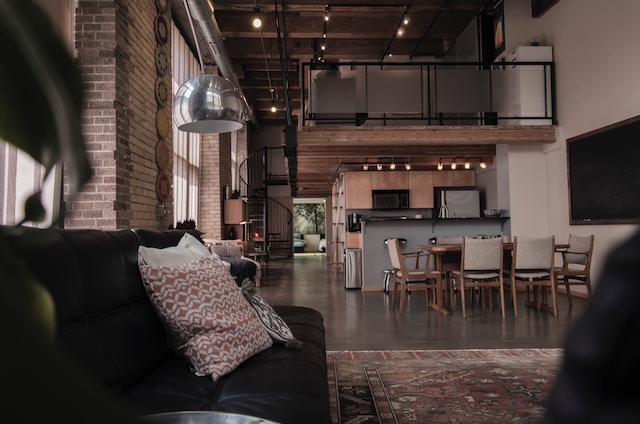Lofts are elevated spaces situated within residences that can be utilized for various purposes. Whether as an additional room, storage area, or for other creative activities, lofts offer flexibility of use.
Below, you will find comprehensive information about the most common locations of lofts, their primary uses, and the distinctions between lofts and finished attics.
+ The Future of Togetherness: Are Dining Rooms a Thing of the Past?
A loft corresponds to a raised area within a house, accessible through a staircase. Generally, they offer views of main living spaces, such as living rooms or kitchens, and function as additional rooms that can be used to relax, work, or sleep.
Comparable to the design of a balcony, they have railings but lack the four conventional gypsum walls present in traditional bedrooms.
Meeting Places
Lofts are more common in contemporary or industrial-style residences. They are also popular in compact urban apartments, where the use of vertical space allows for the creation of new environments even in limited spaces.
The architectural style of a house will influence the specific appearance of the loft. For example, in industrial-style residences, they are often accessed via black metal stairs and feature railings made of the same material. They may be accompanied by exposed brick walls, visible beams, and exposed ducts.
Diverse Uses of Lofts
Due to their location above the main level of the house, lofts are frequently used as offices and living areas. When converted into offices, these spaces provide a comfortable workspace for adults while maintaining visual contact with the family below, as explained by Rachael Grochowski, principal architect of RHG A+ D.
“Lofts are ideal for libraries or as viewpoints,” she suggests. In some cases, lofts used as offices are enclosed with glass, Grochowski adds.
They can also serve as bedrooms, although the absence of conventional walls makes this configuration more common in individual apartments or properties of couples, where privacy is less of a concern.
In certain cases, a raised bedroom might even have a private bathroom, but in others, the sole bathroom will be located on the main floor.
Some people choose to use them as storage spaces instead of traditional attics. In this scenario, lofts are easily accessible areas for storing items such as clothing for different seasons, seasonal and festive decorations, entertainment supplies, crafting materials, and more.
Smaller lofts, as shown here, can be transformed into closets to accommodate clothes hangers and shoe organizers, making the preparation process for the day more enjoyable.
Differences Between Attics and Lofts
An attic is more isolated compared to a loft since it has conventional walls. Moreover, attics often have a more rustic aesthetic, while many lofts adopt a modern and industrial style.
As Patty Cassidy, Director of Interior Design at Ike Baker Velten, notes, “lofts prioritize open space, emphasizing aesthetics and functionality.”
Many are decorated with neutral tones, plants, and elegant pieces. It’s possible to choose a theme or color palette to ensure the loft harmonizes with the rest of the house.
As lofts can be viewed from lower spaces, aesthetic consideration is essential during the design process. The selection of items should be consistent with the rest of the space, avoiding the area from appearing overly cluttered.
The absence of full walls in a loft allows for sound propagation; as an advantage, those on the upper level can easily interact with occupants on the lower level in the main spaces, if desired.
Stay updated on news through our Facebook page!


